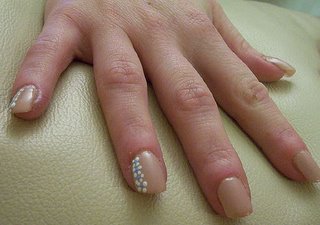Why Marriage Is Good For You When Americans debate the value of marriage, most attention focuses on the potential harm to children of divorce or illegitimacy, and for good reason. Mountains of research tell us that children reared outside of intact marriages are much more likely than other kids to slip into poverty, become victims of child abuse, fail at school and drop out, use illegal drugs, launch into premature sexual activity, become unwed teen mothers, divorce, commit suicide and experience other signs of mental illness, become physically ill, and commit crimes and go to jail. On average, children reared outside of marriage are less successful in their careers, even after controlling not only for income but also for parental conflict.
Yes, marriage protects children. And yes, marriage therefore protects taxpayers and society from a broad and deep set of costs, personal and communal. But there is another case for marriage, equally significant, that you probably haven't heard. Marriage is a powerful creator and sustainer of human and social capital for adults as well as children, about as important as education when it comes to promoting the health, wealth, and well-being of adults and communities. For most Americans, this is news. When it comes to adults, the case for lifelong marriage has been framed in exclusively moral, spiritual, and emotional terms: one side argues for personal liberation from marriage, the other urges parents to sacrifice for God's and/or the kids' sake.
These are important considerations to be sure. Parents surely should be willing to make appropriate sacrifices for their kids' sake. But framing the marriage debate solely in those terms obscures as much as it reveals. It misses the profound benefits that lasting marriage confers on adults. And it overestimates considerably the likelihood that divorce will, in fact, lead to greater happiness for the individual.
Recently, I had the opportunity to review the scientific evidence on the consequences of marriage for adults with University of Chicago scholar Linda J. Waite for our new book, The Case for Marriage. What I found surprised me. Quietly, with little fanfare, a broad and deep body of scientific literature has been accumulating that affirms what Genesis teaches: it is not good for man to be alone—no, nor woman neither. In virtually every way that social scientists can measure, married people do much better than the unmarried or divorced: they live longer, healthier, happier, sexier, and more affluent lives.
How big a difference does marriage make? If David Letterman were to compile a Top Ten list for marriage, it might look something like this:
TOP TEN REASONS WHY MARRIAGE IS GOOD FOR YOU:
10. IT'S SAFER. Marriage lowers the risk that both men and women will become victims of violence, including domestic violence. A 1994 Justice Department report, based on the National Crime Victimization Survey, found that single and divorced women were four to five times more likely to be victims of violence in any given year than wives; bachelors were four times more likely to be violent-crime victims than husbands. Two-thirds of acts of violence against women committed by intimate partners were not committed by husbands but by boyfriends (whether live-in or not) or former husbands or boyfriends. As one scholar sums up the relevant research: "Regardless of methodology, the studies yielded similar results: cohabitors engage in more violence than spouses." Linda Waite conducted an analysis of the National Survey of Families and Households for our new book. She found that, even after controlling for education, race, age, and gender, people who live together are still three times more likely to say their arguments got physical (such as kicking, hitting, or shoving) in the past year than married couples.
9. IT CAN SAVE YOUR LIFE. Married people live longer and healthier lives. The power of marriage is particularly evident in late middle age. When Linda Waite and a colleague, for example, analyzed mortality differentials in a very large, nationally representative sample, they found an astonishingly large "marriage gap" in longevity: nine out of ten married guys who are alive at 48 will make it to age 65, compared with just six in ten comparable single guys (controlling for race, education, and income). For women, the protective benefits of marriage are also powerful, though not quite as large. Nine out of ten wives alive at age 48 will live to be senior citizens, compared with just eight out of ten divorced and single women.
In fact, according to statisticians Bernard Cohen and I-Sing Lee, who compiled a catalog of relative mortality risks, "being unmarried is one of the greatest risks that people voluntarily subject themselves to." Having heart disease, for example, reduces a man's life expectancy by just under six years, while being unmarried chops almost ten years off a man's life. This is not just a selection effect: even controlling for initial health status, sick people who are married live longer than their unmarried counterparts. Having a spouse, for example, lowers a cancer patient's risk of dying from the disease as much as being in an age category ten years younger. A recent study of outcomes for surgical patients found that just being married lowered a patient's risk of dying in the hospital. For perhaps more obvious reasons, the risk a hospital patient will be discharged to a nursing home was two and a half times greater if the patient was unmarried. Scientists who have studied immune functioning in the laboratory find that happily married couples have better-functioning immune systems. Divorced people, even years after the divorce, show much lower levels of immune function.
8. IT CAN SAVE YOUR KID'S LIFE. Children lead healthier, longer lives if parents get and stay married. Adults who fret about second-hand smoke and drunk driving would do well to focus at least some of their attention on this point. In one long-term study that followed a sample of highly advantaged children (middle-class whites with IQs of at least 135) up through their seventies, a parent's divorce knocked four years off the adult child's life expectancy. Forty-year-olds from divorced homes were three times more likely to die from all causes than 40-year-olds whose parents stayed married.
7. YOU WILL EARN MORE MONEY. Men today tend to think of marriage as a consumption item—a financial burden. But a broad and deep body of scientific literature suggests that for men especially, marriage is a productive institution—as important as education in boosting a man's earnings. In fact, getting a wife may increase an American male's salary by about as much as a college education. Married men make, by some estimates, as much as 40 percent more money than comparable single guys, even after controlling for education and job history. The longer a man stays married, the higher the marriage premium he receives. Wives' earnings also benefit from marriage, but they decline when motherhood enters the picture. Childless white wives get a marriage wage premium of 4 percent, and black wives earn 10 percent more than comparable single women.
6. DID I MENTION YOU'LL GET MUCH RICHER? Married people not only make more money, they manage money better and build more wealth together than either would alone. At identical income levels, for example, married people are less likely to report "economic hardship" or trouble paying basic bills. The longer you stay married, the more assets you build; by contrast, length of cohabitation has no relationship to wealth accumulation. On the verge of retirement, the average married couple has accumulated assets worth about $410,000, compared with $167,000 for the never-married and $154,000 for the divorced. Couples who stayed married in one study saw their assets increase twice as fast as those who had remained divorced over a five-year period.
5. YOU'LL TAME HIS CHEATIN' HEART (HERS, TOO). Marriage increases sexual fidelity. Cohabiting men are four times more likely to cheat than husbands, and cohabiting women are eight times more likely to cheat than wives. Marriage is also the only realistic promise of permanence in a romantic relationship. Just one out of ten cohabiting couples are still cohabiting after five years. By contrast, 80 percent of couples marrying for the first time are still married five years later, and close to 60 percent (if current divorce rates continue) will marry for life. One British study found that biological parents who marry are three times more likely still to be together two years later than biological two-parent families who cohabit, even after controlling for maternal age, education, economic hardship, previous relationship failure, depression, and relationship quality. Marriage may be riskier than it once was, but when it comes to making love last, there is still no better bet.
4. YOU WON'T GO BONKERS. Marriage is good for your mental health. Married men and women are less depressed, less anxious, and less psychologically distressed than single, divorced, or widowed Americans. By contrast, getting divorced lowers both men's and women's mental health, increasing depression and hostility, and lowering one's self-esteem and sense of personal mastery and purpose in life.
And this is not just a statistical illusion: careful researchers who have tracked individuals as they move toward marriage find that it is not just that happy, healthy people marry; instead, getting married gives individuals a powerful mental health boost. Nadine Marks and James Lambert looked at changes in the psychological health of a large sample of Americans in the late eighties and early nineties. They measured psychological well-being at the outset and then watched what happened to individuals over the next years as they married, remained single, or divorced. When people married, their mental health improved—consistently and substantially. When people divorced, they suffered substantial deterioration in mental and emotional well-being, including increases in depression and declines in reported happiness. Those who divorced over this period also reported a lower sense of personal mastery, less positive relations with others, less sense of purpose in life, and lower levels of self-acceptance than their married peers did.
Married men are only half as likely as bachelors and one-third as likely as divorced guys to take their own lives. Wives are also much less likely to commit suicide than single, divorced, or widowed women. Married people are much less likely to have problems with alcohol abuse or illegal drugs. In a recent national survey, one out of four single men ages 19 to 26 say their drinking causes them problems at work or problems with aggression, compared with just one out of seven married guys this age.
3. IT WILL MAKE YOU HAPPY. For most people, the joys of the single life and of divorce are overrated. Overall, 40 percent of married people, compared with about a quarter of singles or cohabitors, say they are "very happy" with life in general. Married people are also only about half as likely as singles or cohabitors to say they are unhappy with their lives.
How happy are the divorced? If people divorce in order to be happy, as we are often told, the majority should demand their money back. Just 18 percent of divorced adults say they are "very happy," and divorced adults are twice as likely as married folk to say they are "not too happy" with life in general. Only a minority of divorcing adults go on to make marriages that are happier than the one they left. "Divorce or be miserable," certain cultural voices tell us, but, truth be told, "Divorce and be miserable" is at least as likely an outcome.
This is not just an American phenomenon. One recent study by Steven Stack and J. Ross Eshleman of 17 developed nations found that "married persons have a significantly higher level of happiness than persons who are not married," even after controlling for gender, age, education, children, church attendance, financial satisfaction, and self-reported health. Further, "the strength of the association between being married and being happy is remarkably consistent across nations." Marriage boosted financial satisfaction and health. But being married conferred a happiness advantage over and above its power to improve the pocketbook and the health chart. Cohabitation, by contrast, did not increase financial satisfaction or perceived health, and the boost to happiness from having a live-in lover was only about a quarter of that of being married. Another large study, of 100,000 Norwegians, found that, with both men and women, "the married have the highest level of subjective well-being, followed by the widowed." Even long-divorced people who cohabited were not any happier than singles.
2. YOUR KIDS WILL LOVE YOU MORE. Divorce weakens the bonds between parents and children over the long run. Adult children of divorce describe relationships with both their mother and their father less positively, on average, and they are about 40 percent less likely than adults from intact marriages to say they see either parent at least several times a week.
1. YOU'LL HAVE BETTER SEX, MORE OFTEN. Despite the lurid Sex in the City marketing that promises singles erotic joys untold, both husbands and wives are more likely to report that they have an extremely satisfying sex life than are singles or cohabitors. (Divorced women were the least likely to have a sex life they found extremely satisfying emotionally.) For one thing, married people are more likely to have a sex life. Single men are 20 times more likely, and single women ten times more likely, not to have had sex even once in the past year than the married. (Almost a quarter of single guys and 30 percent of single women lead sexless lives.)
Married people are also the most likely to report a highly satisfying sex life. Wives, for example, are almost twice as likely as divorced and never-married women to have a sex life that a) exists and b) is extremely satisfying emotionally. Contrary to popular lore, for men, having a wife beats shacking up by a wide margin: 50 percent of husbands say sex with their partner is extremely satisfying physically, compared with 39 percent of cohabiting men.
How can a piece of paper work such miracles? For surprisingly, the piece of paper, and not just the personal relationship, matters a great deal. People who live together, for the most part, don't reap the same kinds of benefits that men and women who marry do. Something about marriage as a social institution—a shared aspiration and a public, legal vow—gives wedlock the power to change individuals' lives.
By increasing confidence that this partnership will last, marriage allows men and women to specialize—to take on those parts of life's tasks, from developing an interesting social life to getting money out of insurance companies, that one person does better or enjoys more than the other. Though this specialization is often along traditional gender lines, it doesn't have to be. Even childless married couples benefit from splitting up the work. Married households have twice the talent, twice the time, and twice the labor pool of singles. Over time, as spouses specialize, each actually produces more in both market and non-market goods than singles who have to shoulder all of life's tasks on their own.
But because marriage is a partnership in the whole of life, backed up by family, community, and religious values, marriage can do what economic partnerships don't: give a greater sense of meaning and purpose to life (a reason to exercise or cut back on booze, work harder, and to keep plugging even in the middle of those times when the marriage may not feel gratifying at all). Married people are both responsible for and responsible to another human being, and both halves of that dynamic lead the married to live more responsible, fruitful, and satisfying lives. Marriage is a transformative act, changing the way two people look at each other, at the future, and at their roles in society. And it changes the way significant others—from family to congregation to insurance companies and the IRS—look at and treat that same couple. Sexual fidelity, an economic union, a parenting alliance, the promise of care that transcends day-to-day emotions: all these are what give a few words mumbled before a clergyman or judge the power to change lives.
What proportion of unhappily married couples who stick it out stay miserable? The latest data show that within five years, just 12 percent of very unhappily married couples who stick it out are still unhappy; 70 percent of the unhappiest couples now describe their marriage as "very" or "quite" happy.
Just as good marriages go bad, bad marriages go good. And they have a better chance of doing so in a society that recognizes the value of marriage than one that sings the statistically dubious joys of divorce









